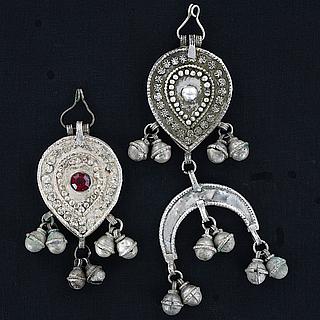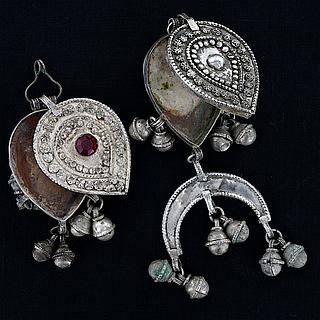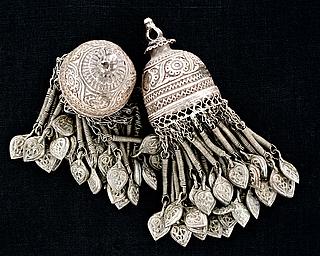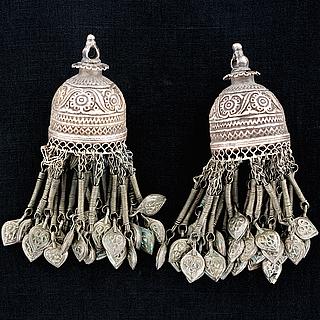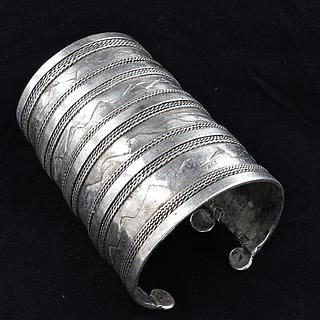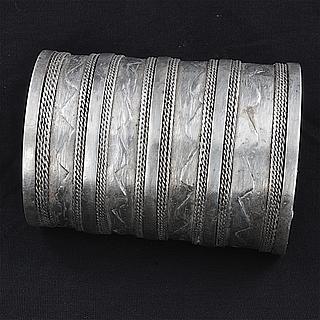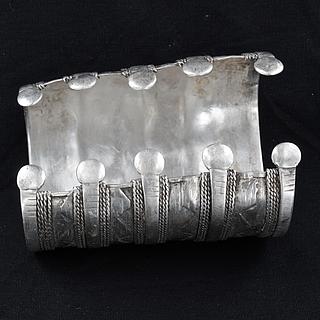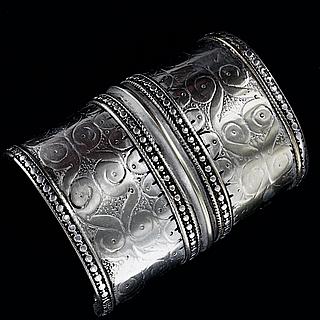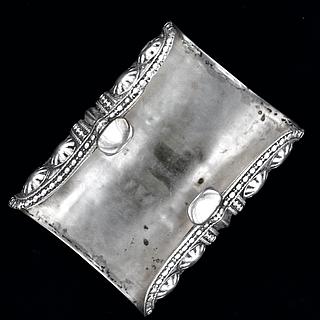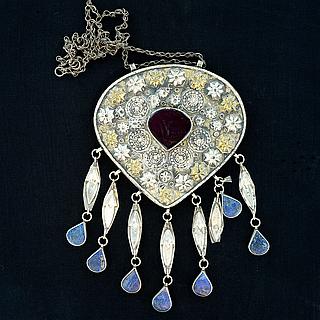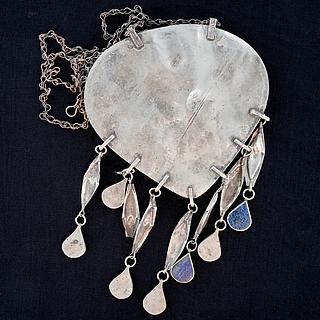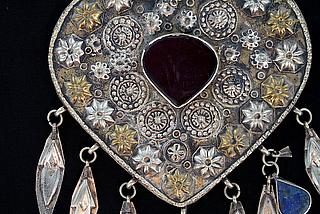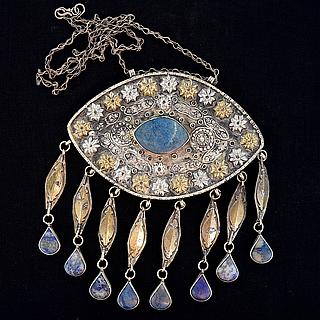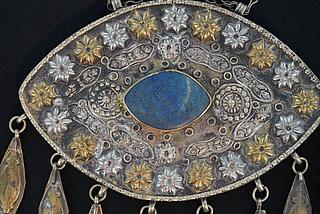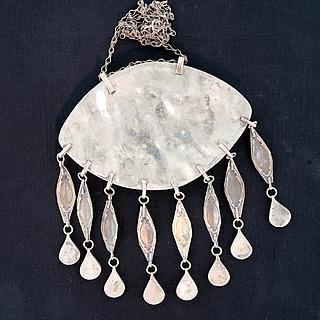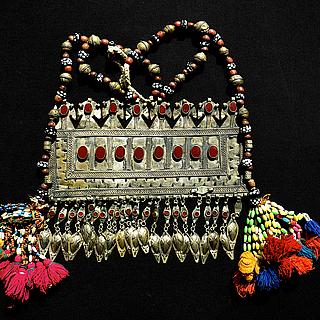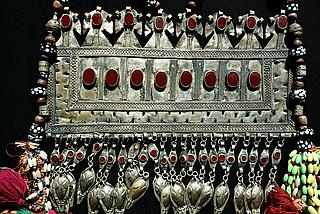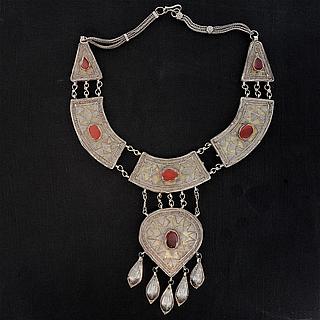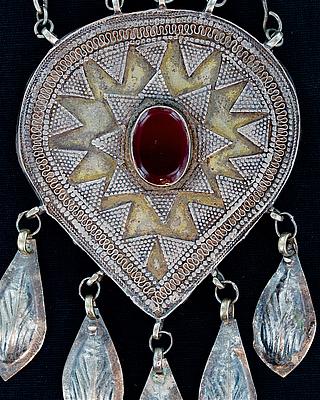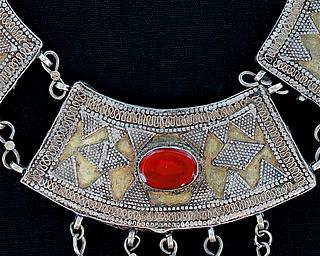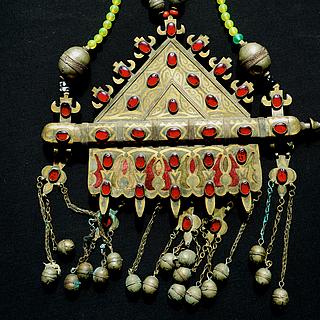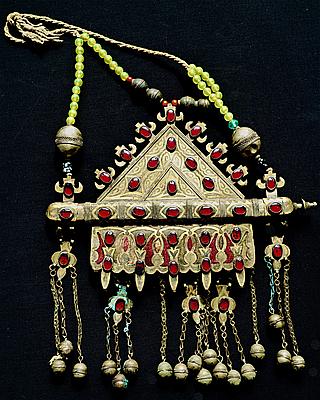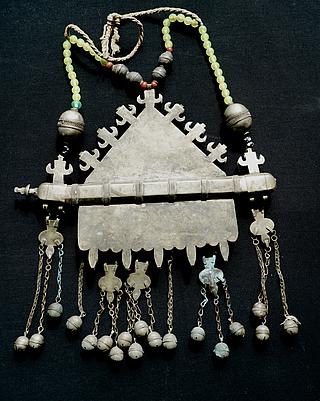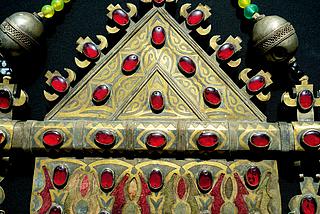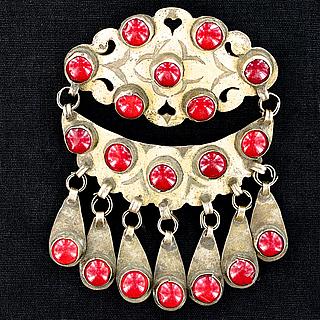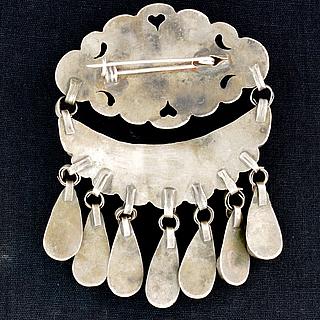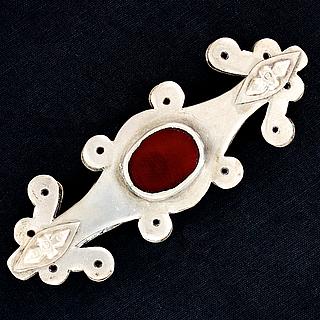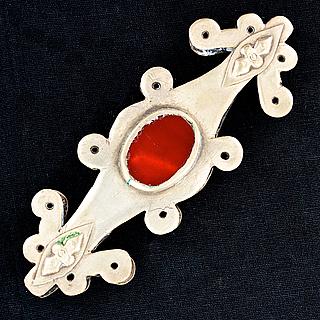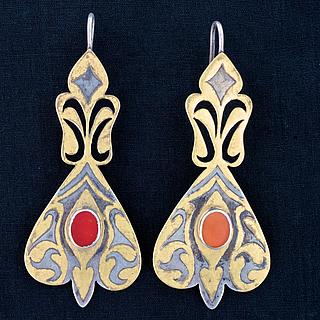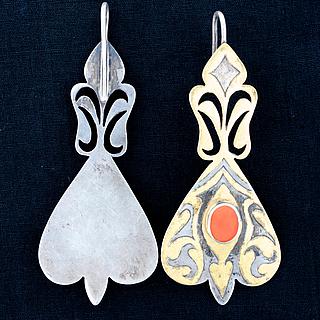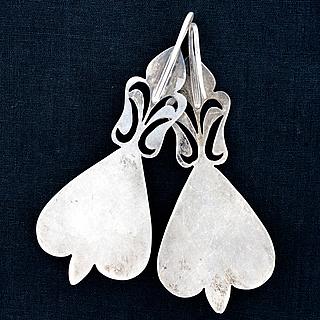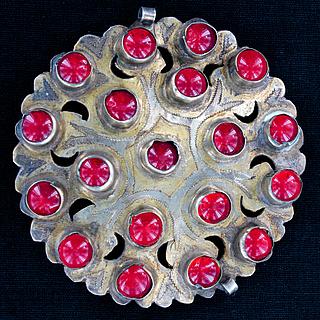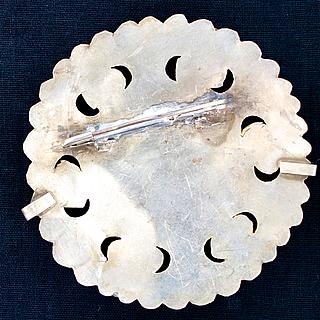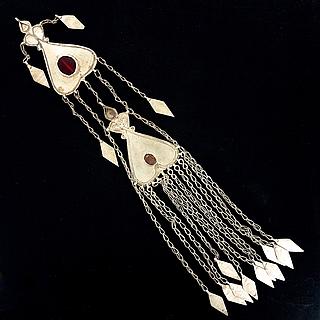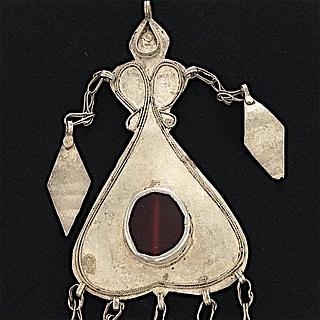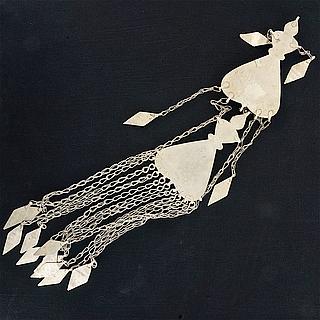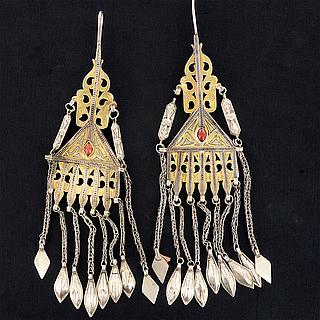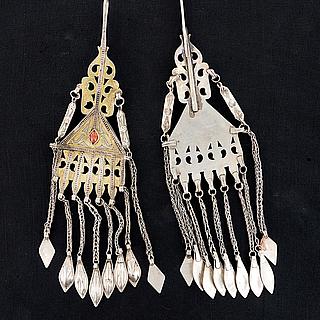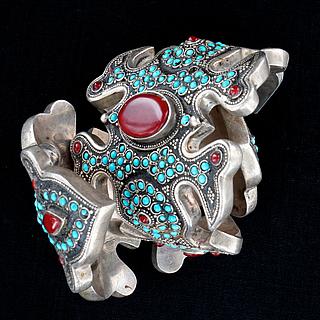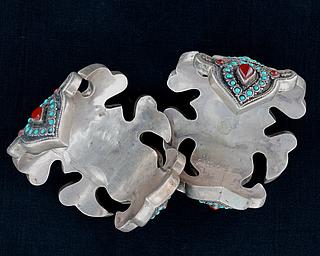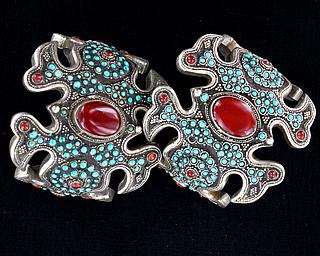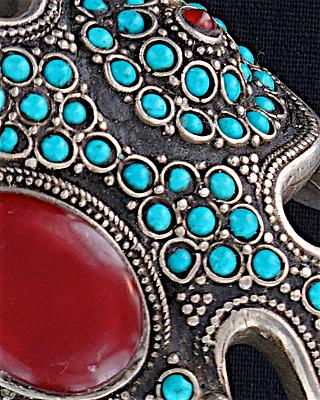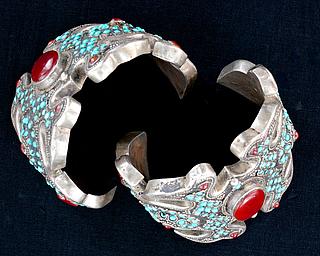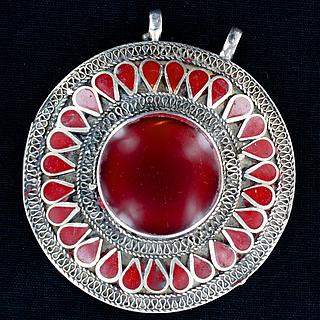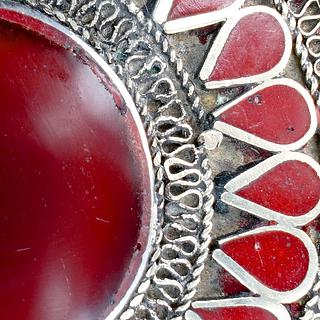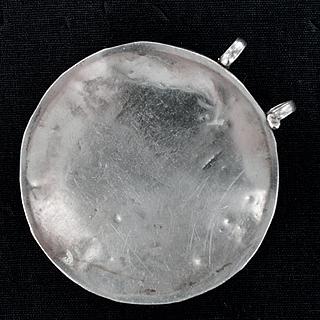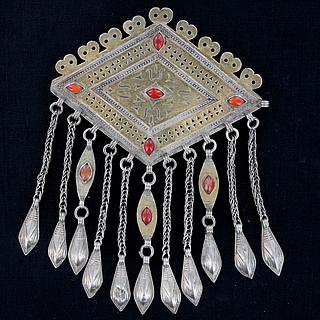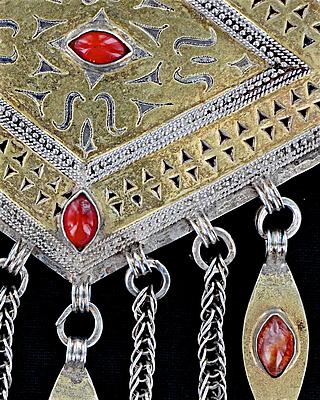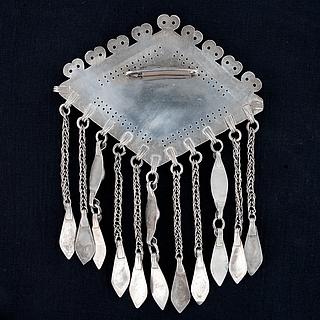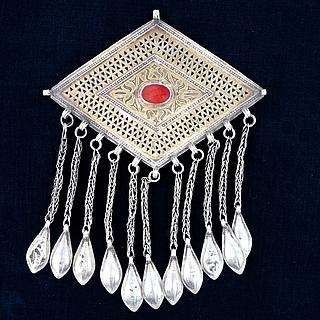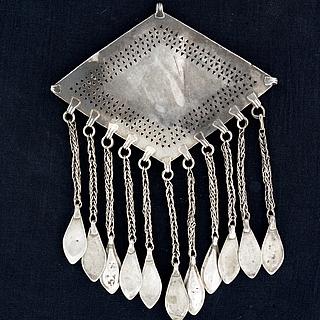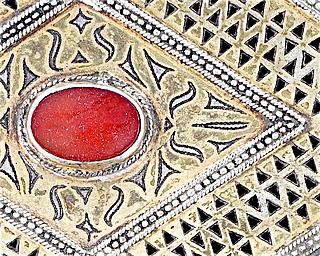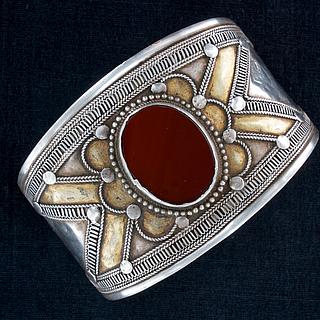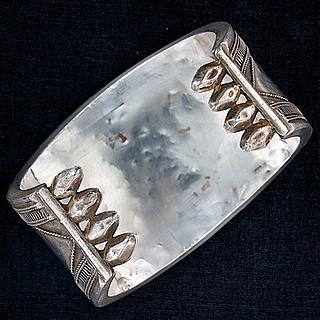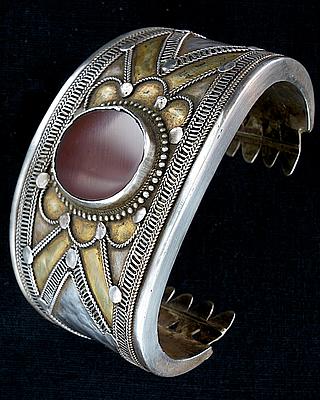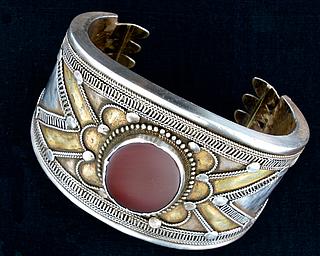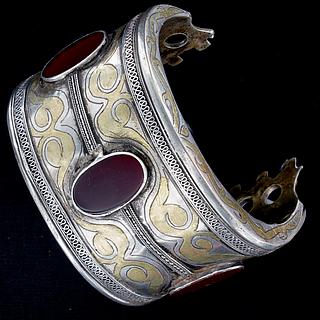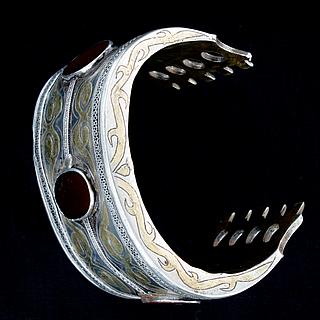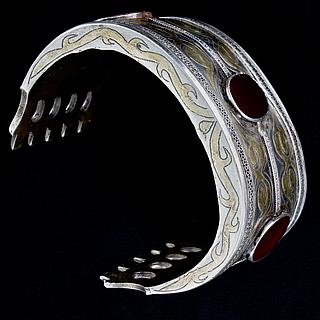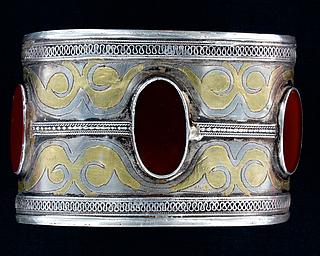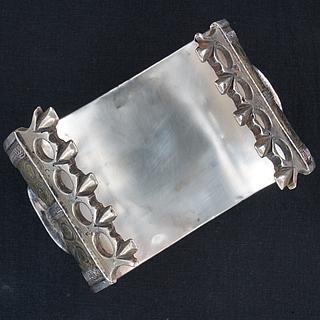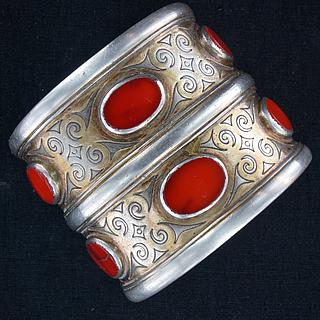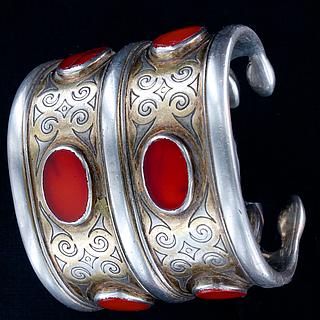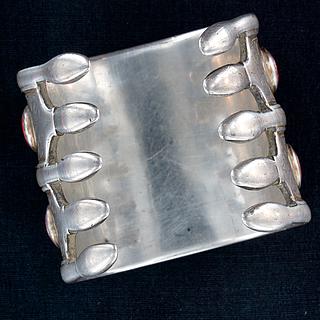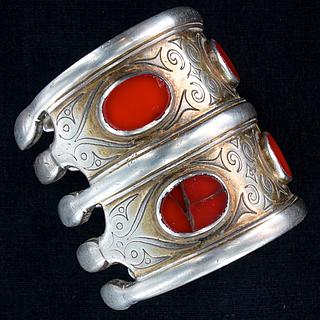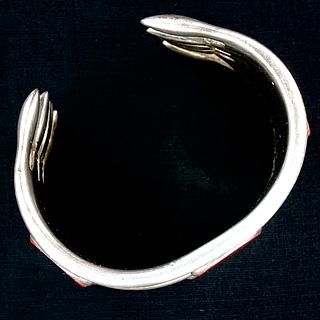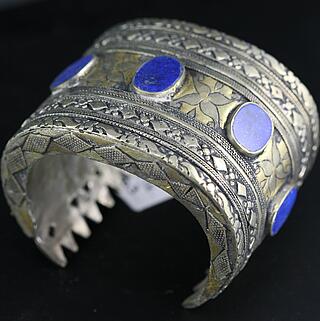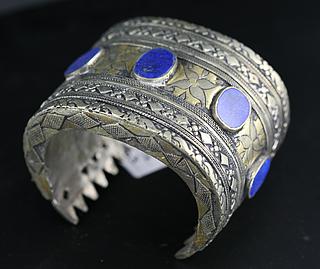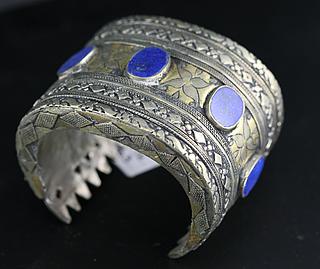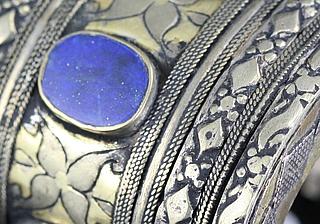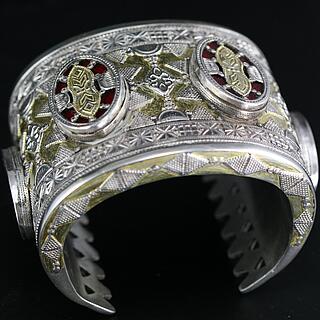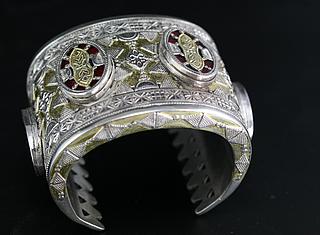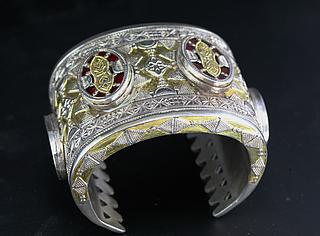Head ornaments worn by women from Tchad and Libya suspended on either side of the face by wool or leather that went over the head and balanced the pair under the ears. Loop closing. Early/mid-20th century. Also make nice bracelets:
A) Silver alloy with punched circular decoration. 50 grams. 8 cm diameter.
B) Silver alloy with punched circular decoration. 49 grams. 7.6 cm diameter.
C) Silver alloy with punched circular decoration. 45 grams. 7 cm diameter.
ORIENTAL JEWELRY 04 / Turkmen & Kazakh Jewelry 04.01 Your search result
Sorting
Refine your search

Reference
Category
Origin
Material
Quality
The Turkmens are a Turkic ethnic group and, according to old beliefs, originate from one common ancestor – Oguza – who gave...read more
The Turkmens are a Turkic ethnic group and, according to old beliefs, originate from one common ancestor – Oguza – who gave rise to several Turkmen groups. The five major tribes of the Turkmen are the Tekke, Esari, Yomut, Choudur, and Saryk. They live primarily in Turkmenistan, northern Afghanistan, Iran and eastern Turkey. Traditionally the Turkmens led and still lead a nomadic or semi-nomadic lifestyle based on animal herding. Their simple lifestyle in the desert and steppe area has influenced the development of a rich material culture. Although nominally Sunni Muslim, the Turkmen kept many of their pre-Islamic customs and beliefs. Turkmen jewellery is distinguished by its extensive repertoire of silver ornaments with chunky, geometric forms. These include, among others, traditional sulsuleh forehead ornaments and chckeliki on the temples, elaborate ceremonial bukau neckalces, chunky bilezik bracelets, heart-shaped asyk ornaments and tumar amulets, as well as circular guliakapendants and diamond-shaped changa worn on a daily basis. The decorations form symmetrical arrangements, engraved, openwork and gilded ornaments with strongly stylised vegetal and animal forms, such as ram’s horns. What distinguishes the decoration of Turkmen jewellery is the use of carnelian, a semi-precious stone. Its red colour symbolises vitality, fertility and happiness, and thus, in the hostile desert and steppe landscape, they acquire a particular significance. Traditional jewellery defined the status of women in the local community and provided protection for the entire family. Karolina Krzywicka: The Andrzej Wawrzyniak Asia and Pacific Museum, Warszawa.
read lessTwo pendants for individual jewellery design04.01.1990
- Aloy with poor silver content
- Collectible (fine or rare example of an object)
- Elements for individual jewelry design
- Excellent overall condition
The two amulet boxes are ideal to design your own necklace.
Antique silver earrings04.03.1962
- High silver content - acid-tested
- Collectible (fine or rare example of an object)
- Museum quality (worthy to be added to a museum’s permanent collection)
- Jewelry for collection or exquisite wearing.
- Excellent overall condition
Beautifull old earrings bought in Afghanistan but they have a strong Turkmen innfluence.
Cuff bracelet - Central Asia04.01.1906
- Silver
- Collectible (fine or rare example of an object)
- Good overall conditions (small imperfections or signs of use)
- Jewelry for collection or exquisite wearing.
Beautiful and easy wearable cuff bracelet probably from northern Afghanistan
Pair of silver cuffs04.01.1905
- Silver
- Collectible (fine or rare example of an object)
- Excellent overall condition
- Jewelry for collection or exquisite wearing.
Pair of extraordinary cuff bracelet probably from northern Afghanistan or Turkmenistan. Beautiful patina, signs of prolonged use. It's rare to findt this type of cuffs as a pair.
Central Asia Pendant Necklace04.01.1458
- Silver
- Carnelian imitations
- Lapis Lazuli
- Collectible (fine or rare example of an object)
- Jewelry for collection or exquisite wearing.
- Fair condition (some missing, broken or repaired parts, see pictures)
This is a beautifully pendant necklace. The Pendant has a raised centre with a heart-shaped carnelian imitation. The pendant also has fine silver repousé work all around. From the pendant dangle 7 dangles with a drop-shaped Lapis Lazuli on each end. One dangle needs to be resoldered, see picture).
Central Asian Pendant Necklace04.01.1456
- White metal, silver content not tested
- Lapis Lazuli
- Collectible (fine or rare example of an object)
- Good overall conditions (small imperfections or signs of use)
- Jewelry for collection or exquisite wearing.
This oval shaped pendant necklace has a raised centre with an oval Lapis Lazuli in its centre. The pendant also has fine repousse work. From the pendant dangle 8 dangles with a drop-shaped Lapis Lazuli on each end.
Rectangular pectoral plate Turkmenistan04.01.1455
- Silver
- Carnelian imitations
- Cotton
- Glass
- Antiques (object shows signs of long use)
- Museum quality (worthy to be added to a museum’s permanent collection)
- Collectible (fine or rare example of an object)
- Excellent overall condition
I was unable to find any reference for this type of pectoral? plate in all my literature on Turkmen jewellery. The only rectangular plate I could see were those used as headgear, but this one seems somewhat rigid to be bent around the forehead, the collar also does not speak for such use.
Necklace "Pashaguly Amangulyev" Turkmenistan04.01.1454
- Silver
- Carnelian
- Excellent overall condition
- Jewelry for collection or exquisite wearing.
- Museum quality (worthy to be added to a museum’s permanent collection)
Rare and extremly pleasant Turkman necklace, easy to wear.
Triangular amulet holder, Tukmenistan04.01.1453
- Gilded or gold foil on silver
- Glass
- Cotton
- Collectible (fine or rare example of an object)
- Fair condition (some missing, broken or repaired parts, see pictures)
- Museum quality (worthy to be added to a museum’s permanent collection)
- Antiques (object shows signs of long use)
Amulet holders, tumars, were produced in a variety of styles and sizes, throughout Central Asia. The present one has a triangular component joined at the bas by a hollow cylinder which housed prayers or qur'an verses. Tumars were worn on the chest. The present example is antique large amulet holder, which lost some of its chains and pendants (see picture). Tumar is the most prestigeous element in a women's wedding finery.
Brooch, Turkmenistan04.01.1452
- Gilded or gold foil on silver
- Glass
- Collectible (fine or rare example of an object)
- Excellent overall condition
Part of the everyday clothing of the Turkmen women. Gilded silver and red glass beads.
Turkmen ??04.01.1451
- Silver/nickel or nickel/copper alloy
- Carnelian
- Collectible (fine or rare example of an object)
- Excellent overall condition
We could find no reference on a similar item. This massive, double-sided elements seem to have been stitched to a cloth, a bag? Could be Qaraqalpaqs
Pair of Adamlyk earrings (temple pendants) Turkmenistan04.01.1450
- Gilded or gold foil on silver
- Carnelian
- Jewelry for collection or exquisite wearing.
- Excellent overall condition
Nice silver, partly fire-gilded and chased pendants, called tenecir, with openworks and a carnelian cabochon. These earrings of the Tekke ethnicity have a stylized anthropomorphic form and are usually worn by unmarried girls.
Turkmenistan circuler disk04.01.1449
- Gilded or gold foil on silver
- Glass
- Jewelry ready and easy to wear
- Good overall conditions (small imperfections or signs of use)
- Elements for individual jewelry design
Part of the everyday clothing of the Turkmen women. Gilded silver and red glass beads.
Women's temple pendant, Turkmenistan04.01.1448
- Silver
- Carnelian
- Collectible (fine or rare example of an object)
- Excellent overall condition
- Jewelry for collection or exquisite wearing.
Women attach the adamlyk to each side of their headdresses to frame the face.
Turkmen (Tekke) earrings "Tenetschir"04.01.1447
- Gilded or gold foil on silver
- Carnelian
- Museum quality (worthy to be added to a museum’s permanent collection)
- Excellent overall condition
- Jewelry for collection or exquisite wearing.
The earrings bear curvilinear motifs taken from the tekke tradition. Invested with a prophylactic role, the bangles add a seductive sound. These earrings were generally attached to a headdress.
Pair of Kasakh bracelets, 04.01.1446
- Silver
- Turquoise
- Carnelian
- Collectible (fine or rare example of an object)
- Fair condition (some missing, broken or repaired parts, see pictures)
- Jewelry for collection or exquisite wearing.
An unusual set of bird-shaped armbands. These remarkable bracelets feature a wavy outline with a myriad of small turquoise and carnelian beads. The centre is occupied by a large carnelian cabochon. One of the cuffs has a small crack on one end. Sometimes referred to as Kuchi, but Kazakh origin seems more likely, even so, if this item was bought in Afghanistan.
Turkman pendentif04.01.1445
- Silver
- Carnelian imitations
- Collectible (fine or rare example of an object)
- Excellent overall condition
- Jewelry ready and easy to wear
Beautiful silver work with a large imitation carnelian in the centre.
Women's coat fastener "Tschapraz", Turkmenistan04.01.1443
- Gilded or gold foil on silver
- Carnelian
- Jewelry for collection or exquisite wearing.
- Museum quality (worthy to be added to a museum’s permanent collection)
- Excellent overall condition
An extraordinary tschapraz, fire-gilded and finely chased. Five oval carnelian beads lovely tassels complete this beautiful piece.
Women's coat fastener "Tschapraz", Turkmenistan04.01.1442
- Gilded or gold foil on silver
- Carnelian
- Jewelry for collection or exquisite wearing.
- Excellent overall condition
- Collectible (fine or rare example of an object)
Excellent ajour work, silver glided with a carnelian cabochon on its centre.
Excellent Turkmen bracelet " Bilezik »04.01.1441
- Gilded or gold foil on silver
- Carnelian
- Jewelry for collection or exquisite wearing.
- Excellent overall condition
This rare bracelet has a lozange shape decorated withone larget red carnelian. Red carnelian was believed to protect the wearer against miscarriage and disease. Red itself was associated with happiness and fertility. The silver is decorated with a rich embossed and applied design and wire. The ends are bordered by motifs known as snake's head, or yilan bash.
Turkmen fire-gilded bracelet "Bilezik"04.01.1440
- Gilded or gold foil on silver
- Silver
- Carnelian
- Jewelry for collection or exquisite wearing.
- Excellent overall condition
This braclet known as Qasli Bilezik is decorated with three table-cut oval red carnelians. Red carnelian was believed to protect the wearer against miscarriage and disease. Red itself was associated with happiness and fertility. The silver is decorated with an embossed and applied design and wire. The bracelt is likely from the Yomund tribe.
Turkmen fire-gilded bracelet "Bilezik"04.01.1439
- Gilded or gold foil on silver
- Silver
- Carnelian
- Jewelry for collection or exquisite wearing.
- Excellent overall condition
- Collectible (fine or rare example of an object)
This heavy bracelet known as bilezik is decorated with two rows of 3 table-cut red carnelians. Red carnelian was believed to protect the wearer against miscarriage and disease. Red itself was associated with happiness and fertility. There are six such plaques on each bracelet.The silver is decorated with an embossed and applied design and wire. The ends are bordered by motifs known as snake's head, or yilan bash. One carnelian has some cracks.
Pair of Kazakh Bracelet04.01.221
- Silver
- Lapis Lazuli
- Collectible (fine or rare example of an object)
- Excellent overall condition
- Jewelry for collection or exquisite wearing.
Kazakh Silver bracelet with claw, from Central Asia ( Kazakhstan ). It is decorated with stylised floral engraved motifs and embellished with gold plating. Five raised oval sections are set with Lapis Lzuli. These bracelets are not adjustable due to their solid and rigid construction, as the antique pieces are.
Kazakh Bracelet04.01.220
- Silver
- Glass
- Excellent overall condition
- Jewelry for collection or exquisite wearing.
A stunning silver cuff bracelet open on one side and edged with serrated, triangular elements known as ‘snakes’ heads’ meant to symbolise life and give the wearer talismanic protection. It is decorated with engraved motifs and embellished with fire gilding (gold plating) and applied granular work. Four raised oval sections are set with deep red glass. Bracelets such as this were often part of a bride's dowry. The size cannot be adjusted.

